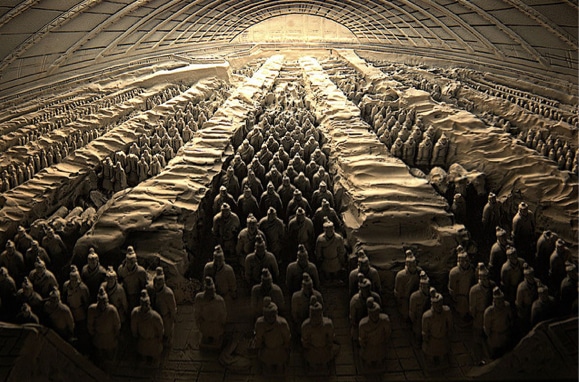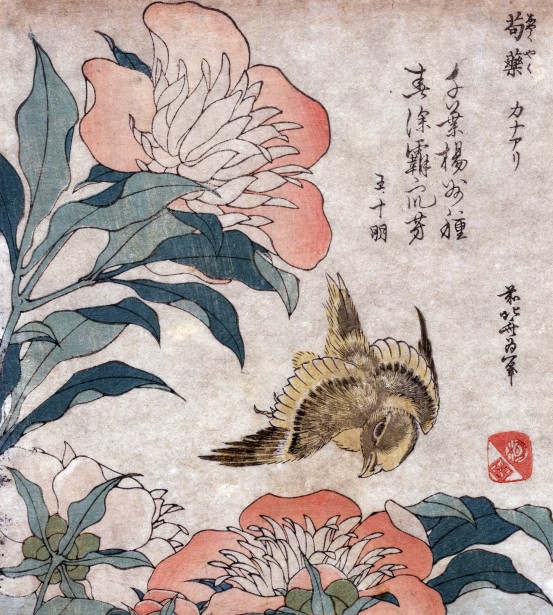The every day people, rather than the ones that were high in power.

Indian, Chinese and Japanese: 653 BCE - 1900 CE

Indian, Chinese and Japanese: 653 BCE - 1900 CE
Characteristics: Serene, meditative art, and Arts of the Floating World
Chief Artists and Major Works: Gu Kaizhi, Li Cheng, Guo Xi, Hokusai, Hiroshige
Historical events: Birth of Buddha (563 BCE); Silk Road opens (1st Century BCE); Buddhism spreads to China (1st-2nd Centuries CE) and Japan (5th Century CE).
The art of the Indian, Chinese and Japanese are all heavily influenced by the culture and the way of life of the people. These influences changed the art for the time period to something that told us of the every day people, rather than the ones that were high in power.
Asian Arts, which includes Indian, Chinese and Japanese have the characterists of showing the culture and history of the country where it is from. The spiritual and natural are also high characteristics. Hiroshige displays this in much of his art work.
Chinese Art

Chinese Art

Chinese art are the forms of art that have been influenced by great philosophers, teachers, religious figures and political leaders. In the beginning of the era, the early forms of the chinese art included pottery and jade. Ceramics were mainly unpainted and most often cord-marked. The Bronze Age in China has more elaborate objects which included ritual vessels. Within the Zhou Dynasty in China, the taotie motif is most common. This shows a mythological being presented frontally as though squashed onto a horizontal plane to form a symmetrical design.
In the early imperial China, th ematerial of porcelain was found and introduced to the culture and the art. Porcelain was refined to the point that in English, the word china has become synonymous with high-quality porcelain.

In China, The Terracotta Army was made in the Qin Dynasty. It stands inside the Mausoleum of the First Qin Emperor and consists of more than 7,000 life-size tomb terracotta figures of warriors and horses buried with the First Emperor of Qin. The Terracotta Army belonged, and still belongs to Emperor Qin Shi Huang. The Terracotta Army are there to guard his burial site as well as protecting the entry to the afterlife. Emperor Qin Shi Huang was the dynasty Emperor who managed to unify China so that it became a central state and it was also because of him that the foundations of the Great Wall were laid down.

Paintings in the traditional style involved the same technique as calligraphy and is done with a brush dipped in black or coloured ink. In the Tang Dynasty, the primary subject matter was the landscapes that generally involved mountains and mountain water. These were known as shanshui paintings. The landscapes are usually monochromatic and sparse. Its purpose is to grasp an emotion or atmosphere so as to catch the rhythm of nature.
.jpg)
In the late imperial china, under the Ming dynasty, narrative painting became a large part of the artwork. There was also a wider colour range and the composition was busier. Song paintings became immensely popular during the time. European culture also started to have its impact at this time.
Indian Art
Indian Art

Indian art can be classified into specific periods, which reflect particular religious, political and cultural developments. The Indian art to the Western culture can seem overly ornate and sensuous.
Bronze and stones were most commonly used in Indian sculptures. They became more explicit, representing episodes of the Buddha's life and teachings.
Outside homes, Rangoli is used. This is a form of sand painting decoration that uses finely ground white powder and colours.

Known as one of the 7 Wonders of the World, as one of India's greatest pieces of architecture and art, the Taj Mahal was built by Mughal Emperor Shah Jahan, in memory of his third wife, Mumtaz Mahal. It has been described and recognized as "the jewel of Muslim art in India and one of the universally admired masterpieces of the world's heritage".

All together, the classical Indian architecture, sculpture, painting, literature, music and dancing evolved their own rules conditioned by their respective media, but they shared with one another not only the underlying beliefs but also the procedures by which the relationship of the symbols and the spiritual states were worked out in detail.

Japanese Art
Japanese art used a wide range of art styles and media including ancient pottery, sculpture in wood and bronze, ink painting on silk and paper, and more recently, and perhaps what Japan is famous for in the modern day, manga and cartooning. However, painting is the preferred method of the Japanese artists. In Japan, they also traditionally write with a brush rather than a pen. Some still use a pot of ink, but more in modern times, you can get pens which do the exactly the same style.

The Japanese ceramics are some of the finest in the world and are the earliest known artefacts of the culture. There has also been identified a heavy use of natural materials for architecture and a relationship between interior and exterior spaces.
In history, Japan has been subject to sudden invasions with new and alien ideas, which are soon followed by long periods of almost isolation from the outside world. The Japanese have taken all this into consideration throughout history and they are able to absorb, imitate and assimilate the elements of foreign culture that complimented their aesthetic preferences.

In the 7th and 8th centuries, in connection with Buddhism, the Japanese created complex artworks. However, in the 9th century, the Japanese started to turn away from China and Buddhism and developed their own forms of expression through their arts. After the Onin War, Japan was in a period of political, social, and economic disruption that continued for over a century. The state that emerged under the leadership of Tokugawa shogunate, organised religion played a small role in people's lives, and the arts that survived through this period were primarily secular.
Throughout Japan, painting is the preferred medium and the preferred way in which artists like to express themselves through art. The Japanese, much like the Chinese, wrote with a brush, and this familiarity with the brush has aided the Japanese to become particularly sensitive to the values and aesthetics of painting.

Within the Edo period, a popular culture that arose, the style of woodblock prints called ukiyo-e became a prime art form and the techniques were fine tuned to produce colourful prints on everything from daily new news to schoolbooks.
Most Japanese sculpture is associated with religion, and the medium of sculpture is in decline due to the lessening importance of traditional Buddhism. However, Japanese ceramics are still among the finest in the world and include the earliest known artefacts of their culture.
In history, Japan has been subject to sudden invasions with new and alien ideas, which are soon followed by long periods of almost isolation from the outside world. The Japanese have taken all this into consideration throughout history and they are able to absorb, imitate and assimilate the elements of foreign culture that complimented their aesthetic preferences.

In the 7th and 8th centuries, in connection with Buddhism, the Japanese created complex artworks. However, in the 9th century, the Japanese started to turn away from China and Buddhism and developed their own forms of expression through their arts. After the Onin War, Japan was in a period of political, social, and economic disruption that continued for over a century. The state that emerged under the leadership of Tokugawa shogunate, organised religion played a small role in people's lives, and the arts that survived through this period were primarily secular.
Throughout Japan, painting is the preferred medium and the preferred way in which artists like to express themselves through art. The Japanese, much like the Chinese, wrote with a brush, and this familiarity with the brush has aided the Japanese to become particularly sensitive to the values and aesthetics of painting.

Within the Edo period, a popular culture that arose, the style of woodblock prints called ukiyo-e became a prime art form and the techniques were fine tuned to produce colourful prints on everything from daily new news to schoolbooks.
Most Japanese sculpture is associated with religion, and the medium of sculpture is in decline due to the lessening importance of traditional Buddhism. However, Japanese ceramics are still among the finest in the world and include the earliest known artefacts of their culture.

Sources:
www.sideshare.net/mobile/RodriguezArt/asian-art-14705443
https://www.google.co.uk/webhp?sourceid=chrome-instant&ion=1&espv=2&ie=UTF-8#q=chinese+art
https://www.google.co.uk/webhp?sourceid=chrome-instant&ion=1&espv=2&ie=UTF-8#q=chinese+art
https://www.google.co.uk/search?q=indian+art&espv=2&biw=1536&bih=783&source=lnms&tbm=isch&sa=X&ved=0CAYQ_AUoAWoVChMI3oed5ODwxgIVybcUCh0e8wtZ#tbm=isch&q=traditional+indian+art&imgrc=_
https://en.wikipedia.org/wiki/Japanese_art
https://www.google.co.uk/search?q=japanese+art&espv=2&biw=944&bih=951&tbm=isch&tbo=u&source=univ&sa=X&ved=0CCAQsARqFQoTCPeasuXh8MYCFckX2wodORsGqg#tbm=isch&q=japanese+art+flowers&imgrc=mcJnmACZbcySDM%3A
Up Next: Byzantine and Islamic Art
https://en.wikipedia.org/wiki/Japanese_art
https://www.google.co.uk/search?q=japanese+art&espv=2&biw=944&bih=951&tbm=isch&tbo=u&source=univ&sa=X&ved=0CCAQsARqFQoTCPeasuXh8MYCFckX2wodORsGqg#tbm=isch&q=japanese+art+flowers&imgrc=mcJnmACZbcySDM%3A
Up Next: Byzantine and Islamic Art
No comments:
Post a Comment